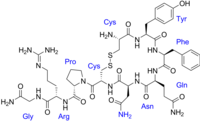
Photo from wikipedia
Myocardial infarction (MI) is a leading cause of death worldwide. For those who survive the acute insult, the progressive dilation of the ventricle associated with chronic heart failure is driven… Click to show full abstract
Myocardial infarction (MI) is a leading cause of death worldwide. For those who survive the acute insult, the progressive dilation of the ventricle associated with chronic heart failure is driven by an adverse increase in circulating levels of the antidiuretic hormone, vasopressin, which is secreted from hypothalamic supraoptic (SON) and paraventricular nuclei (PVN) nerve terminals. Although increased vasopressin neuronal activity has been demonstrated in the latter stages of chronic heart failure, we hypothesised that vasopressin neurones become activated immediately following an acute MI. Male Sprague‐Dawley rats were anaesthetised and an acute MI was induced by ligation of the left anterior descending coronary artery. After 90 minutes of myocardial ischaemia, brains were collected. Dual‐label immunohistochemistry was used to quantify the expression of Fos protein, a marker of neuronal activation, within vasopressin‐ or oxytocin‐labelled neurones of the hypothalamic PVN and SON. Fos protein and tyrosine hydroxylase within the brainstem were also quantified. The results obtained show that the expression of Fos in both vasopressin and oxytocin neurones of the PVN and SON was significantly elevated as soon as 90 minutes post‐MI compared to sham rats. Moreover, Fos protein was also elevated in tyrosine hydroxylase neurones in the nucleus tractus solitarius and rostral ventrolateral medulla of MI rats than sham rats. We conclude that magnocellular vasopressin and oxytocin neuronal activation occurs immediately following acute MI, rather than in the later stages of chronic heart failure. Therefore, prompt vasopressin antagonist therapy as an adjunct treatment for acute MI may impede the progression of ventricular dilatation, which remains a key adverse hallmark of chronic heart failure.
Journal Title: Journal of Neuroendocrinology
Year Published: 2019
Link to full text (if available)
Share on Social Media: Sign Up to like & get
recommendations!